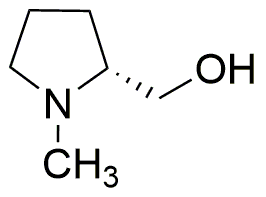(R)-1-Methyl-2-pyrrolidinemethanol is widely utilized in research focused on
- Pharmaceutical Development: This compound serves as an important intermediate in the synthesis of various pharmaceuticals, particularly in the development of drugs targeting the central nervous system.
- Chiral Auxiliary: It is used as a chiral auxiliary in asymmetric synthesis, helping researchers create enantiomerically pure compounds, which are crucial for the efficacy and safety of many drugs.
- Solvent Applications: The compound can act as a solvent in organic reactions, providing a medium that enhances reaction rates and yields, particularly in the synthesis of complex organic molecules.
- Research in Neurochemistry: Its unique structure allows for studies in neurochemistry, aiding in understanding neurotransmitter systems and potential therapeutic targets for neurological disorders.
- Material Science: It is explored for use in developing new materials, particularly in the creation of polymers with specific properties, such as improved flexibility and strength.
General Information
Properties
Safety and Regulations
Applications
(R)-1-Methyl-2-pyrrolidinemethanol is widely utilized in research focused on
- Pharmaceutical Development: This compound serves as an important intermediate in the synthesis of various pharmaceuticals, particularly in the development of drugs targeting the central nervous system.
- Chiral Auxiliary: It is used as a chiral auxiliary in asymmetric synthesis, helping researchers create enantiomerically pure compounds, which are crucial for the efficacy and safety of many drugs.
- Solvent Applications: The compound can act as a solvent in organic reactions, providing a medium that enhances reaction rates and yields, particularly in the synthesis of complex organic molecules.
- Research in Neurochemistry: Its unique structure allows for studies in neurochemistry, aiding in understanding neurotransmitter systems and potential therapeutic targets for neurological disorders.
- Material Science: It is explored for use in developing new materials, particularly in the creation of polymers with specific properties, such as improved flexibility and strength.
Documents
Safety Data Sheets (SDS)
The SDS provides comprehensive safety information on handling, storage, and disposal of the product.
Product Specification (PS)
The PS provides a comprehensive breakdown of the product’s properties, including chemical composition, physical state, purity, and storage requirements. It also details acceptable quality ranges and the product's intended applications.
Certificates of Analysis (COA)
Search for Certificates of Analysis (COA) by entering the products Lot Number. Lot and Batch Numbers can be found on a product’s label following the words ‘Lot’ or ‘Batch’.
*Catalog Number
*Lot Number
Certificates Of Origin (COO)
This COO confirms the country where the product was manufactured, and also details the materials and components used in it and whether it is derived from natural, synthetic, or other specific sources. This certificate may be required for customs, trade, and regulatory compliance.
*Catalog Number
*Lot Number
Safety Data Sheets (SDS)
The SDS provides comprehensive safety information on handling, storage, and disposal of the product.
DownloadProduct Specification (PS)
The PS provides a comprehensive breakdown of the product’s properties, including chemical composition, physical state, purity, and storage requirements. It also details acceptable quality ranges and the product's intended applications.
DownloadCertificates of Analysis (COA)
Search for Certificates of Analysis (COA) by entering the products Lot Number. Lot and Batch Numbers can be found on a product’s label following the words ‘Lot’ or ‘Batch’.
*Catalog Number
*Lot Number
Certificates Of Origin (COO)
This COO confirms the country where the product was manufactured, and also details the materials and components used in it and whether it is derived from natural, synthetic, or other specific sources. This certificate may be required for customs, trade, and regulatory compliance.


